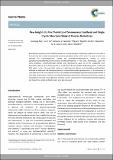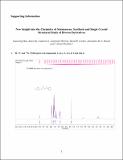Files in this item
New insight into the chemistry of selenoureas : synthesis and single crystal structural study of diverse derivatives
Item metadata
| dc.contributor.author | Hua, Guoxiong | |
| dc.contributor.author | Du, Junyi | |
| dc.contributor.author | Carpenter-Warren, Cameron Lewis | |
| dc.contributor.author | Cordes, David B. | |
| dc.contributor.author | Slawin, Alexandra M. Z. | |
| dc.contributor.author | Woollins, John D. | |
| dc.date.accessioned | 2020-04-16T23:32:17Z | |
| dc.date.available | 2020-04-16T23:32:17Z | |
| dc.date.issued | 2019-05-14 | |
| dc.identifier | 259062352 | |
| dc.identifier | ea1427b8-c835-47c3-835b-bf41a41f27bd | |
| dc.identifier | 85065519087 | |
| dc.identifier | 000468633200024 | |
| dc.identifier.citation | Hua , G , Du , J , Carpenter-Warren , C L , Cordes , D B , Slawin , A M Z & Woollins , J D 2019 , ' New insight into the chemistry of selenoureas : synthesis and single crystal structural study of diverse derivatives ' , New Journal of Chemistry , vol. 43 , no. 18 , pp. 7035-7043 . | en |
| dc.identifier.issn | 1144-0546 | |
| dc.identifier.other | ORCID: /0000-0002-9527-6418/work/57821723 | |
| dc.identifier.other | ORCID: /0000-0002-5366-9168/work/57821910 | |
| dc.identifier.other | ORCID: /0000-0002-1498-9652/work/59464694 | |
| dc.identifier.uri | https://hdl.handle.net/10023/19816 | |
| dc.description | Authors are grateful to the University of St Andrews for financial support and the EPSRC National Mass Spectrometry Service Centre (Swansea) for mass spectral measurements. | en |
| dc.description.abstract | Reacting benzoyl chloride with KSeCN in acetone at room temperature, followed by treatment in situ with 4-bromoaniline led to N-((4-bromophenyl)carbamoselenoyl)benzamide in 93% yield. The same reaction was observed for 4-methoxybenzoyl chloride and 4-pentafluorosulfanylaniline, leading to N-((4-pentafluorosulfanylphenyl)carbamoselenoyl)-4-methoxybenzamide in 76% yield. Interestingly, under the same conditions, 4-methoxybenzoyl chloride and 4-bromoaniline gave rise of the unexpected 2-((4-bromophenyl)amino)-2-methylpropanenitrile and 6-bromo-2,2,4-trimethyl-1,2-dihydroquinoline in 45% and 52% yields. Further, the equivalent reaction of 4-nitrobenzoyl chloride and 4-pentafluorosulfanylaniline afforded an additional 3-(4-nitrobenzoyl)imino-5-(4-(pentafluorosulfanyl)phenylamino)-1,2,4-diselenazole in 19% yield apart from the expected 4-nitro-N-((4-(pentafluorosulfanyl)phenyl)carbamoselenoyl)benzamide in 79% yield. Furthermore, a series of five-membered selenium heterocycles was obtained from the reaction of N-acylselenoureas with various phenacyl bromides. All new compounds were characterised spectroscopically, and twelve X-ray single crystal structures were also discussed. | |
| dc.format.extent | 9 | |
| dc.format.extent | 1570066 | |
| dc.format.extent | 2174782 | |
| dc.language.iso | eng | |
| dc.relation.ispartof | New Journal of Chemistry | en |
| dc.subject | QD Chemistry | en |
| dc.subject | DAS | en |
| dc.subject.lcc | QD | en |
| dc.title | New insight into the chemistry of selenoureas : synthesis and single crystal structural study of diverse derivatives | en |
| dc.type | Journal article | en |
| dc.contributor.institution | University of St Andrews. School of Chemistry | en |
| dc.contributor.institution | University of St Andrews. EaSTCHEM | en |
| dc.contributor.institution | University of St Andrews. Office of the Principal | en |
| dc.description.status | Peer reviewed | en |
| dc.date.embargoedUntil | 2020-04-17 |
This item appears in the following Collection(s)
Items in the St Andrews Research Repository are protected by copyright, with all rights reserved, unless otherwise indicated.


